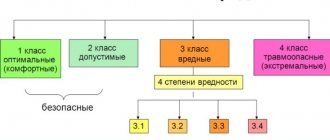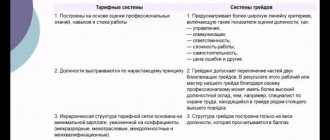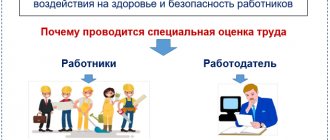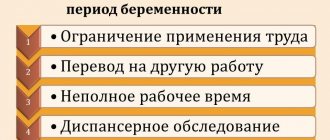Article 14. Classification of working conditions
1. Working conditions according to the degree of harmfulness and (or) danger are divided into four classes - optimal, acceptable, harmful and dangerous working conditions.
2. Optimal working conditions (class 1) are working conditions under which there is no exposure to harmful and (or) hazardous production factors on the employee or the levels of exposure of which do not exceed the levels established by standards (hygienic standards) of working conditions and accepted as safe for humans , and the prerequisites are created to maintain a high level of employee performance.
Harmful working conditions class 3 1 and 3 2 benefits
Acceptable working conditions (class 2) are working conditions under which the employee is exposed to harmful and (or) dangerous production factors, the levels of exposure of which do not exceed the levels established by the standards (hygienic standards) of working conditions, and the altered functional state of the employee’s body is restored during regulated rest or by the beginning of the next working day (shift).
4. Harmful working conditions (class 3) are working conditions under which the levels of exposure to harmful and (or) hazardous production factors exceed the levels established by the standards (hygienic standards) of working conditions, including:
1) subclass 3.1 (harmful working conditions of the 1st degree) - working conditions under which the employee is exposed to harmful and (or) dangerous production factors, after exposure to which the altered functional state of the employee’s body is restored, as a rule, in a longer period than before the next working day (shift), the cessation of exposure to these factors, and the risk of health damage increases;
2) subclass 3.2 (harmful working conditions of the 2nd degree) - working conditions under which the employee is exposed to harmful and (or) dangerous production factors, the levels of exposure of which can cause persistent functional changes in the employee’s body, leading to the appearance and development of initial forms of occupational diseases or occupational diseases of mild severity (without loss of professional ability) arising after prolonged exposure (fifteen years or more);
3) subclass 3.3 (harmful working conditions of the 3rd degree) - working conditions under which the employee is exposed to harmful and (or) dangerous production factors, the levels of exposure of which can cause persistent functional changes in the employee’s body, leading to the appearance and development of occupational diseases of mild and moderate severity (with loss of professional ability to work) during the period of working activity;
4) subclass 3.4 (harmful working conditions of the 4th degree) - working conditions under which the employee is exposed to harmful and (or) dangerous production factors, the levels of exposure of which can lead to the emergence and development of severe forms of occupational diseases (with loss of general working capacity) during the period labor activity.
5. Hazardous working conditions (class 4) are working conditions in which the employee is exposed to harmful and (or) hazardous production factors, the levels of exposure to which during the entire working day (shift) or part of it can create a threat to the life of the employee, and the consequences of exposure These factors cause a high risk of developing an acute occupational disease during working life.
6. If workers employed in workplaces with hazardous working conditions use effective personal protective equipment that has undergone mandatory certification in the manner established by the relevant technical regulations, the class (subclass) of working conditions may be reduced by the commission on the basis of the expert opinion of the organization conducting the special assessment of working conditions, one degree in accordance with the methodology approved by the federal executive body, which carries out the functions of developing and implementing state policy and legal regulation in the field of labor, in agreement with the federal executive body, carrying out the functions of organizing and implementing the federal state sanitary and epidemiological supervision, and taking into account the opinion of the Russian Tripartite Commission for the Regulation of Social and Labor Relations.
7. In agreement with the federal executive body exercising the functions of organizing and implementing federal state sanitary and epidemiological supervision, it is allowed to reduce the class (subclass) of working conditions by more than one degree in accordance with the methodology specified in Part 6 of this article.
(as amended by Federal Law dated May 1, 2016 N 136-FZ)
(see text in previous)
8. With regard to workplaces in organizations carrying out certain types of activities, a reduction in the class (subclass) of working conditions can be carried out in accordance with industry specifics approved by the federal executive body exercising the functions of developing and implementing state policy and legal regulation in the field labor, in agreement with the federal executive body exercising the functions of organizing and implementing federal state sanitary and epidemiological supervision, and taking into account the opinion of the Russian Tripartite Commission for the Regulation of Social and Labor Relations.
9. The criteria for classifying working conditions in the workplace are established by the methodology for conducting a special assessment of working conditions provided for in Part 3 of Article 8 of this Federal Law.
The procedure for assigning a hazard class
Assignment is carried out on the basis of a methodology that is described in detail in the relevant Order of the Ministry of Labor.
This procedure is regulated by federal law.
In accordance with these documents, the assessment procedure must be carried out at least once every 5 years. Along with scheduled assessments, unscheduled assessments can also be organized in connection with the following events:
- Commissioning of new production, office premises, workplaces (both in buildings and on the street).
- Significant changes in production processes, modernization of technology, installation of new production equipment.
- Changes in the composition of materials, raw materials used in the production process.
- Identification of a disease that is recognized as an occupational one, as well as an accident (provided that its causes are not related to the actions/inaction of third parties).
Expert opinion
Salomatov Sergey
Real estate expert
Previously, we talked about how the characteristics of working conditions for ITU are described, see more about this here.
The employer must conduct a job assessment directly (on his own initiative and at his own expense). To do this, the company turns to organizations that provide relevant services (subject to a state license).
The procedure consists of several stages - organizing the work of the commission, identifying and assessing factors, assigning a hazard class, and drawing up reports. Such a company must simultaneously work at least 5 experts, and each of them must also have a personal certificate giving the right to engage in the relevant activity. The organization itself must be registered in the register of companies assessing working conditions, and its constituent documents must also reflect information about this type of activity.
Step 1. Hazard identification
After concluding an agreement with this company, the employer issues an order to begin the work of the commission (the total number of people must represent an odd number). The commission includes not only representatives of the organization, but also representatives of the employer itself, and exactly 1 of them heads this body.
Factor identification is made on the basis of a classifier, which was developed in the annex to the described Order of the Ministry of Labor.
Step 2. Research of hazardous factors and assignment of a hazard class
The study is designed to assess the degree of danger, for which a quantitative or qualitative assessment of each of the detected factors is carried out. Then a specific class is assigned. The criteria for assigning a factor to a particular class must be clarified in regulatory documents - primarily in SanPiNs and GN (hygienic standards).
When determining the hazard class, it is not always possible to proceed only from quantitative indicators. In some cases, a factor can only be described qualitatively, for example:
- Psycho-emotional stress.
- Intellectual load.
- Static and dynamic load.
- The monotony of work.
- Tilts of the body, duration of holding in one position, etc.
Step 3. Completing the report
Based on the results of the work, the commission draws up a protocol and a report of the established form. The documents reflect the full composition of the commission, information about the company, the hazard class for each factor, etc.
https://youtu.be/Dp4F1yJDGfY
Types of guarantees and compensation
The results of a special assessment of working conditions (SOUT) can be used to establish guarantees and compensation for workers provided for by the Labor Code (Articles 21, 92, 117, 147) of the Russian Federation (according to Federal Law No. 426 on December 28, 2013) for working in hazardous and dangerous conditions. These include:
- Reduced working hours.
- Annual additional paid leave.
- Increased wages.
- The right to early assignment of a labor pension.
- Providing therapeutic and preventive nutrition.
- Conducting periodic medical examinations.
Since January 1, 2014, significant changes have occurred in the procedure for providing some of the above types of guarantees and compensation.
Types of benefits
Federal Law No. 426 establishes 4 classes of working conditions, in particular:
- optimal;
- acceptable;
- harmful;
- dangerous.
Naturally, optimal conditions are considered the norm and do not require any measures other than control. But class 2 is considered acceptable, which presupposes the presence of certain factors that can lead to disorders of health functions on a short-term basis and which can be relieved by providing protective equipment and rest.
Hazardous conditions corresponding to class 4 are quite rare, given that work with chemical elements and radiation is present only in companies with a certain specificity.
But class 3 is more common due to the fact that it takes into account many factors present in most companies, from dust and vibration, to employment in conditions of elevated temperature, not to mention working with gas welding or fumes. And given that there are quite a lot of dangerous factors, this class is divided into subclasses that make it possible to take into account the degree of impact and provide benefits to compensate for the harm caused.
In particular, the following benefits are established :
- additional leave;
- reduced hours of work per week;
- additional payment as a percentage of the salary or hourly rate;
- conducting medical examinations;
- early retirement;
- issuance of special food;
- accident insurance;
- ban on holding multiple positions.
Reduced working hours
According to Article 91 of the Labor Code of the Russian Federation, the standard working hours per week is 40 hours. Workers who, based on the results of the assessment, are employed in conditions recognized as harmful and classified as harmful levels 3.3 and 3.4 are entitled to a reduction in the standard of working hours to 36 , on the basis of Article 92 of the Labor Code of the Russian Federation.
At the same time, they have the right to work a full week, but only for additional pay, because a difference of 4 hours for them will already be overtime work, which is paid in accordance with Article 152 of the Labor Code of the Russian Federation.
Annual additional paid leave
Based on Article 117 of the Labor Code of the Russian Federation, workers in the presence of a hazard class: 3.2,3.3,3.4 are also entitled to an additional rest period of at least 7 days , paid in the amount of average earnings and to be provided in the order of priority, determined by the schedule.
Moreover, the minimum duration of this rest period is established at the legislative level, and the company’s management, at its own expense, can increase its length.
Increased wages
Required for work in conditions deviating from normal, and an additional payment of 4% on the basis of Article 147 of the Labor Code of the Russian Federation.
Moreover, this type of incentive is provided to all employees with a hazard class of 3 at the place of work, regardless of the subclass, but at the industry level, increased amounts may be provided for some categories of citizens, naturally in direct proportion to the degree of harm.
Conducting periodic medical examinations
In pursuance of the norms of Article 212 of the Labor Code of the Russian Federation, the company's management is obliged to periodically implement measures aimed at identifying the development of occupational diseases by conducting periodic medical examinations of all company employees.
However, workers employed in conditions that deviate from normal conditions and have a hazard class of 3 are also subject to:
- psychiatric examination in accordance with the norms of Federal Law No. 3185-1;
- medical examination to prevent the development of HIV (Federal Law No. 38);
- examination to prevent the development of tuberculosis disease (Federal Law No. 77).
Providing therapeutic and preventive nutrition
Decree of the Government of the Russian Federation No. 168 states that in the event of hazardous employment conditions at work, workers are entitled to receive at least half a liter of milk per shift or preventive nutrition, which the specified product can replace.
A separate classification for each product is not established due to the fact that milk compensation is provided based on a list of harmful factors and position held.
That is, if there is a hazard class of 3.1 and 3.2, you can count on receiving milk if the worker is employed, for example, in the energy sector or construction work.
The right to early assignment of a labor pension
Pension provision for workers is regulated by the norms of Article 30 of Federal Law No. 400, according to which persons employed in an industry with harmful factors have the right to receive a pension early, that is, upon reaching 55 years for men and 50 years for women, respectively.
Moreover, the early assignment of the agreed payment directly depends on the name of the position, which must be present in List No. 1 or No. 2, and the accumulated experience in a certain industry and conditions.
Accident insurance
In accordance with the procedure specified in Federal Law No. 125, the company's management is obliged to insure employees against accidents, as well as provide certain guarantees in connection with injury to employees employed in class 3 hazardous conditions.
In particular, in accordance with the norms enshrined in Article 17, employees are sent to resort treatment, and are also provided with medicines and payment for treatment at the expense of the enterprise.
Prohibition on part-time work
In accordance with Article 282 of the Labor Code of the Russian Federation, working as a part-time worker is possible at several enterprises, taking into account the standard hours and the availability of free time.
However, if a worker at his main place of employment works in conditions classified as hazard class 3, and similar factors are present in his part-time position, he is not subject to additional employment, due to the excess of the norm of negative impact and the risk of developing serious diseases.
Reduced working hours
With the introduction of new legislation, a shortened 36-hour working week should be provided only to those workers whose working conditions correspond to the 3rd and 4th degree of hazard (classes 3.3 and 3.4) or are classified as hazardous working conditions.
Previously, the legislation did not provide for such a distinction. Consequently, in workplaces where working conditions are classified as hazard classes 3.1 and 3.2, working hours are 40 hours per week.
In this case, the length of working time for a particular employee is determined by an employment contract on the basis of an industry (inter-industry) agreement and a collective agreement, taking into account the results of the special labor assessment.
Allowed compensation
For employees who belong to class 3, the following additional payments and compensations are provided.
Vacation
Certification of workplaces or special assessment of working conditions
Article number 117 of the Labor Code of the Russian Federation provides for additional vacation days for workers who belong to class 3. 3, harmful working conditions or related to hazardous conditions.
In this case, an additional number of days is required, which is at least seven. The specific quantity is determined on the basis of the employment contract and the intersectoral agreement used in this practice. It can also be determined by a collective agreement based on a special assessment.
An employee may choose monetary compensation in exchange for an increased duration of leave, if this is provided for in the submitted contracts and agreements.
Reduced labor hours
According to the legislation that considers the levels of working conditions, the right to a shortened working week, which lasts 36 hours, is available to employees who are within the third and fourth levels of harmfulness and danger of work (that is, subclasses 3.3 or 3.4, as well as class 4) .
Important! Workers whose specialty belongs to subclasses 3.1 and 3.2 must work a full working week, the duration of which is forty hours.
However, for each specific specialist, the number of working hours can be revised in accordance with an intersectoral agreement, or a collective agreement based on a special assessment.
Receiving special food
The Labor Code of the Russian Federation provides for an employee to receive therapeutic and preventive nutrition if he has to work in harmful and dangerous conditions.
Note! This may mean receiving dairy or other products, as well as specialized therapeutic and preventative nutrition.
Pension
Workers in certain professions or industries that have dangerous and harmful working conditions based on a special assessment of special working conditions may receive early retirement. The presented right is provided for by law.
List of industries and professions whose workers can retire early:
- nuclear energy production;
- production of glass, porcelain or earthenware;
- production of chemicals;
- gas, oil or coal processing industry;
- electronic and radio industry;
- production of materials for construction;
- pulp industry;
- mining, underground and mining operations;
- metallurgical industry, which produces non-ferrous and ferrous metals;
- production of ammunition and other explosives.
Early retirement, types of work
A complete list of specialties, work performed and industries is indicated in Decree of the Government of the Russian Federation under number 665. In more detail, all the data relating to pension provision for workers in hazardous and hazardous conditions can be found on the Internet. For example
The employer is provided with the allocation of additional funds to the Pension Fund of the Russian Federation for employees of the third and fourth classes.
Increased salary
The Labor Code addresses the issue of increasing wages for employees of enterprises who work in class 3.3. The increase in pay must be at least four percent.
Note! The exact figure is determined directly by the employer, taking into account labor and collective agreements.
Annual additional paid leave
Previously, the minimum duration of additional paid leave when working in harmful and (or) dangerous working conditions was 7 days (RF Government Decree No. 870 of November 20, 2008) and was not related to the hazard class, but now the situation has changed.
Now additional leave (according to Article 117 of the Labor Code of the Russian Federation) for work in hazardous working conditions is provided to employees whose working conditions at their workplaces, according to the results of the special assessment of labor conditions, are classified as hazardous working conditions of the 2nd, 3rd or 4th degree (classes 3.2, 3.3 and 3.4) or dangerous working conditions.
In this case, the minimum duration of additional leave is 7 days, its specific amount is established by the employment contract on the basis of an industry (inter-industry) agreement and a collective agreement, taking into account the results of the special labor assessment.
There is also the possibility of replacing additional leave with monetary compensation, which should be provided for by industry (inter-industry) agreements and a collective agreement.
How to determine the harmfulness of a profession?
Whether certain working conditions at an enterprise are harmful or dangerous to the health of an employee is determined as follows:
- a special assessment of working conditions is carried out and, based on the results obtained, the conditions are determined as harmful or hazardous to health;
- workplaces are certified if a special assessment of working conditions has not been carried out;
- working conditions may be recognized as hazardous to health in accordance with regulations (lists, lists of occupations with hazardous working conditions for 2020), including documents approved by the USSR, but to the extent that does not contradict the current Labor Code of the Russian Federation.
Thus, whether certain professions belong to professions with hazardous working conditions should first of all be determined based on the results of an assessment of working conditions or certification of workplaces. Previously, whether a particular profession was classified as hazardous was determined based on an approved list.
The fact that employees perform their work duties under hazardous working conditions imposes certain obligations on the employer. So, it is worth considering that some categories of workers cannot work in such work. Such workers include minors, in some cases women (for example, a woman cannot work as an electric welder if the work involves working on high-rise buildings), and part-time workers if the main job is also hazardous. According to the Labor Code, the harmful working conditions in which workers work must be compensated by increased wages (Article 146 of the Labor Code of the Russian Federation). Employers should take into account that this is not the only compensation for difficult working conditions - employees are also provided with other compensation:
- for employees, reduced work time in hazardous working conditions should be established (if employees work in work that has a 3 or 4 level of harmfulness);
- employees working in difficult conditions must be provided with additional paid leave (this applies to employees who work in jobs that have more than 2 levels of harmfulness);
- the employer must provide employees with free food (milk or sour milk, hot breakfasts, vitamins, etc.);
- if necessary, the employer must provide workers with special clothing, footwear and other means to perform the work.
Harmful working conditions
No. 10, regardless of the establishment of harmful and/or dangerous factors in these workplaces, then from 01/01/2014, in order to include periods of work in the special length of service for early retirement, it is necessary to establish harmful and/or dangerous factors based on the results of the Special Assessment of Labor and Safety.
As a result, early retirement is due to men upon reaching the age of 50 years and women upon reaching the age of 45 years, in jobs with hazardous working conditions and in hot shops and have an insurance period of at least 20 and 15 years, respectively.
Since 2013, for working in hazardous working conditions, the employer must make additional contributions to the Pension Fund of the Russian Federation.
| Class of working conditions | Subclass of working conditions | Additional insurance tariff. contribution (%) |
| Dangerous | 4 | 8,0 |
| Harmful | 3.4 | 7,0 |
| 3.3 | 6,0 | |
| 3.2 | 4,0 | |
| 3.1 | 2,0 | |
| Acceptable | 2 | 0,0 |
| Optimal | 1 | 0,0 |
If the employer does not make additional contributions to the Pension Fund of the Russian Federation, then this period of work is not counted towards the length of service for early retirement.
In fact, the employee needs to check whether the employer makes these contributions, otherwise he may lose his early pension.
Pivot table
| Name of compensation | Harm class | ||||
| 3.1 | 3.2 | 3.3 | 3.4 | 4 | |
| Increased wages | + | + | + | + | + |
| Annual additional paid holiday | — | + | + | + | + |
| Shortened working hours time | — | — | + | + | + |
Sanitary and hygienic standards
General requirements
Workplaces differ from each other in a large number of ways and have different requirements. Standards for working conditions at workplaces will, accordingly, also differ. Let us list the general sanitary and hygienic characteristics by which the normative maximum permissible concentrations and maximum permissible limits are recorded. To provide the employee with an adequate environment, the following indicators are monitored:
- room temperature;
- level of air humidity or dryness;
- how well the place is ventilated and blown; whether there are unacceptable vapors or gases in the air;
- compliance with SanPiN standards for illumination;
- degree of noise exposure;
- presence of ultrasound or vibrations;
- presence or absence of radiation;
- workplace size;
- mode of work and rest.
To assess optimal environmental factors, two main parameters and several additional ones are used (given in the table):
- maximum permissible concentration - this concept is used to assess the concentration of substances;
- maximum permissible level - determines the upper limit of the impact factor, i.e. the maximum level.
Basic legislative norms of the Russian Federation:
- R 2.2.2006-05. 2.2. Occupational hygiene. Guidelines for hygienic assessment of working environment and labor process factors. Criteria and classification of working conditions - approved by the Chief State Sanitary Doctor of the Russian Federation on July 29, 2005.
- On special assessment of working conditions - Federal Law 426 of December 28, 2013 (as amended on December 27, 2018).
- On approval of the Methodology for conducting a special assessment of working conditions, the Classifier of harmful and (or) hazardous production factors, the report form for a special assessment of working conditions and instructions for filling it out - Order of the Ministry of Labor of Russia No. 33n dated January 24, 2014 (as amended on November 14, 2016) .
IMPORTANT!
From January 1, 2014, instead of the concept of workplace certification (Article 209 of the Labor Code), a special assessment of working conditions was introduced, which is carried out in accordance with Federal Law No. 426 of December 28, 2013.
Requirements for conditions for women
For them, special hygienic requirements for working conditions in the workplace have been established and applied:
- reduced levels of all SanPiN indicators, negative effects and concentrations of substances, physical activity indicators;
- mandatory medical examination upon hiring;
- Stationary workplaces and work performed in a free mode are preferred; constant standing and sitting work is unacceptable;
- the level of noise and vibration does not exceed MPL 3;
- work without night shifts;
- the degree of risk in relation to one’s own life or others is excluded;
- hearing load - up to 90%;
- visual load 1 no more than 50% of working time;
- women's labor is mechanized as much as possible;
- air temperature - from 19 to 25 °C.
Legislation:
- On the regulation of hygienic requirements for working conditions for women - letter of Rospotrebnadzor dated July 4, 2018 No. 09-6240-2018-40.
- Section 2.2. Occupational hygiene. Hygienic requirements for working conditions for women - SanPiN 2.2.0.555-96. Sanitary rules, norms and hygienic standards.
Results
The whole burden of defending decent working conditions and adequate compensation for harmful and dangerous working conditions falls on the shoulders of workers.
The role of the trade union has increased significantly, which is now required to negotiate on an equal footing with the employer to conclude a collective agreement that would establish greater guarantees for employees than labor legislation.
Additional information: www.trudcontrol.ru.
· Last changes: 2016/09/18 20:48 —
Harmful working conditions class 3.1 and 3.2: benefits and compensation for the employee
What is due to employees “for harmfulness” based on the results of a special assessment Now the minimum amounts, procedure and conditions for providing guarantees and compensation to employees “for harmfulness” are spelled out directly in the Labor Code of the Russian Federation, Articles 92, 117, 147, 219 of the Labor Code of the Russian Federation. Previously, they were installed by the Government. 219 of the Labor Code of the Russian Federation (as amended, valid until 01/01/2014); Government Decree No. 870 dated November 20, 2008. Let us say right away that the minimum amounts of guarantees and compensation have not changed. However, according to the results of the special assessment, separate guarantees are not provided not only to workers employed in optimal and acceptable working conditions, as was the case before, but also to some of the “harmful workers”.
Benefits for employees working in hazardous working conditions
The act was issued on December 28, 2013, No. 426-FZ.
- Federal Law “On Labor Pensions”, number 173-FZ. It was last edited November 19, 2020;
- Decree of the Government of the Russian Federation “On Amendments to Certain Acts of the Government of the Russian Federation”. The act was issued on February 10, 2020 under number 168.
One of the main legislative acts is the Sanpin, which establishes criteria for the absence of a threat from environmental factors to the human body and their harmlessness.
The act contains sanitary and epidemiological norms and rules that ensure favorable conditions for human life. The main points of harmful working conditions of classes 3.1 and 3.2 An employee is granted certain rights if production factors are included in subclasses 3.1 and 3.2.
Harmful working conditions class 3.1 and 3.2: benefits and compensation for the employee
As a basis for calculating additional payments for harmfulness, it is customary to use the Standard Regulations on the Assessment of Working Conditions, introduced on October 3, 1986. In accordance with it, the following calculation algorithm is used:
- Identification of the hazard class by comparing the established maximum permissible indicators with the hazard parameters actually existing in a particular production.
- Conversion of production hazard classes (established in reporting documents for certification or assessment of working conditions) into points based on the following table: Class 3.1 Class 3.2 Class 3.3 Class 3.4 1 2 3 4
- Establishing the period of influence of negative factors. The amount of the surcharge is determined taking into account the period of actual stay in the area affected by the negative factor.
- Determining the amount of additional payment for harm to a specific employee.
Characteristics of class 3 and its subclasses
The Labor Code provides for the division of working conditions according to the degree of harm to humans into four classes. The 1st and 2nd correspond to optimal conditions that are either absolutely safe for the health of workers or do not exceed the upper threshold of acceptable hygiene standards. However, they are extremely rare, like the most dangerous 4th class. The most widespread is class 3 - harmful working conditions (class 3.1, 3.2, 3.3).
With it, the degree of risk exceeds the norms allowed by the Labor Code. Each of the identified subclasses differs in the severity of the consequences for humans:
- 1 - class 3.1 according to a special assessment of working conditions is characterized by the least dangerous workplace. Under the influence of working environment factors, the state of the body changes. The recovery period is long and takes a day. Subclass 3.1 of the class of working conditions is harmful if the employee goes on shift earlier than 24 hours;
- 2 - harmful factors cause persistent changes in health, which develop into diseases. But the employee does not lose his ability to work and can continue to perform professional duties in full. However, he must monitor his health and undergo regular medical examinations to prevent the disease from progressing;
- 3 - class 3.3 working conditions are characterized by an increased degree of danger. Under such conditions, workers develop diseases that, if progressed, can cause loss of ability to work.
This clear division into subclasses allows employers to make decisions to improve existing working conditions and minimize work risks.
Harmful working conditions class 3.1 and 3.2 in Russia in 2020
In this case, if working conditions are considered optimal or acceptable, guarantees and compensation are subject to cancellation in full. However, if the working conditions class is 3.1 or 3.2, then it will not be possible to remove, for example, a shortened working week. Thus, the types and volume of guarantees and compensation will remain the same for all workers working in hazardous working conditions, regardless of class (subclass).
The third option allows for a differentiated approach to the assignment of guarantees and compensation depending on the class (subclass) of working conditions. In our opinion, the inclusion in the collective agreement of a phrase stating that guarantees and compensation are assigned “based on the results of special labor assessment for work in harmful and (or) dangerous working conditions depending on the class (subclass) of working conditions” is mandatory for employers who do not want and cannot provide employees with benefits greater than those required by law.
Cancellation of additional leave for hazardous working conditions class 3. 1
Labor Code of the Russian Federation Reduced working hoursArticles 92, 94 Labor Code of the Russian Federation Optimal (class 1) Increases in wages compared to normal working conditions are not provided Additional leave “for harmfulness” is not provided Reduction of working hours is not made Acceptable (class 2) Harmful (class 3):
Wages are increased by at least 4% of the tariff rate (salary) established for various types of work with normal working conditions. Specific amounts of wage increases are established by local regulations or a collective or labor agreement
Additional leave of at least 7 calendar days is provided.
Srg in the media
Attention
The appointment of guarantees and compensation should be formalized by an additional agreement to the employment contract (Article 72 of the Labor Code of the Russian Federation), which comes into force from the date of approval of the special assessment report. Please note that the agreement must indicate the specific amounts and types of guarantees and compensation provided. The employment contract with the employee must contain information about working conditions at the workplace and their characteristics (Art.
57 Labor Code of the Russian Federation). It will be enough to indicate the final class (subclass) of working conditions, which is indicated in line 030 of the special assessment card. Information about working conditions must be included in the employment contract, even if they are considered optimal or acceptable, that is, when benefits are not provided.
Compensation for “harmfulness” before and after a special assessment of working conditions
Thus, persons exposed to the negative impact of negative factors can expect to receive increased wages. Each employee who performs his or her job functions under the negative influence of production factors has the right to count on receiving these payments, which represent a salary supplement if it was established based on the results of certification activities before the beginning of 2014. This threshold was established due to the fact that until 2014 there were regulations requiring mandatory certification of workplaces in order to determine the presence of harmful and dangerous factors.
Federal Law No. 426-FZ of December 28, 2013 replaced certification with an assessment of the working conditions of personnel. At the same time, by virtue of Part 4 of Art.
Additional payment for hazardous working conditions in 2018
Info
It states that dairy products are to be issued on the basis of an approved list of production factors classified as hazard classes 3.1 and 3.2 according to the workplace occupied. Is monetary compensation possible? Cash compensation to an employee is paid in accordance with the norm of hours worked if the working week exceeds 36 hours. The procedure for calculating and conditions for making payments, methods for determining the amount are provided for in the interindustry agreement and the collective agreement of the enterprise.
A prerequisite is to obtain the written consent of the employee, which is attached to the employment contract. Which professions may lose their harmfulness Classification of production factors is carried out depending on the level of their impact on the human body. It is established during the assessment of production working conditions.
- Categories
- Labor law
- In 2013, workplace certification was carried out at our enterprise. The chemical analysis laboratory assistant was assigned hazard class 3.1, i.e. he is entitled only to monetary compensation in the amount of 4% of the tariff rate. And the attestation sheets contain the word “yes” for additional leave. How to understand this, because additional leave is allowed only with hazard class 3.2. And based on the results of the previous certification, the laboratory assistant received additional leave of 12 days. What to do? Do we have the right to cancel additional leave and leave only monetary compensation? And what legal documents should we be guided by? Thanks in advance for your answer.
ImportantBased on this, they can be:
- optimal;
- acceptable;
- harmful;
- dangerous.
The degree of exposure of workers to harmful factors may vary. In cases where it exceeds certain values, the existing working conditions are considered harmful. It is believed that when performing work functions in such conditions, the risk of developing occupational illnesses increases significantly.
Harmful conditions must be distinguished by drawing a line from hazardous conditions. It is customary to speak of hazardous conditions when personnel are exposed to factors that directly have a negative impact on their health. An example in this case is the work of painters in paint shops. If such employees have the necessary protective equipment, the conditions in which they work are considered harmful. Such activities usually include actions aimed at:
- effective modernization of equipment, premises and means of labor;
- providing specialists with individual protective kits that help reduce the harmful effects of harmful factors.
If, as a result of the measures taken, the impact on people of harmful factors was not completely eliminated, however, the hazard class was lowered, then employers have the right to reduce the percentage of compensation payments. The decision to provide (or refuse to provide) payments of this nature is made by organizations in the process of reviewing reports on assessing the working conditions of employees. Employees have the right to disagree with the employer’s decision to refuse to provide compensation or with the decision to downgrade the hazard class.
Classification of working conditions in the workplace
The workplace can be harmful to an employee if there is a negative factor associated with production activities that penetrates directly into the body or has an impact through wave radiation. Health deteriorates over time, and an occupational disease or injury appears that prevents a normal life and/or the birth of healthy children.
Some harmful factors have little effect on the body, others have a weak effect, and others significantly worsen health and well-being. In this regard, harmful working conditions are usually divided into classes and subclasses, depending on the level of exposure to humans. The basis for the assessment is the conditions in which the employee feels good.
The assessment of working conditions is carried out by the State Labor Safety Inspectorate. The size and procedure for assigning benefits, compensation and additional payments to an employee depends on what degree it assigns to a particular workplace.
In total, there are 4 classes of harmful effects on humans of working conditions:
| 1 class (Optimal) | 2 classes (Acceptable) | 3 grades (Harmful) | 4th grade (Dangerous) |
| Working conditions allow the employee to feel normal, maintain health and high performance. Over time, diseases do not appear, injuries do not occur. | Established hygienic standards for permissible concentrations are not exceeded. During the rest period, the employee fully recovers his strength, after which he returns to work. Work does not negatively affect well-being and health and does not interfere with the appearance of healthy offspring. | Working conditions involve the presence of harmful factors that have an undesirable effect on the body and the future generation of children. | Work involves a constant risk to health and life due to the presence of factors that strongly affect health and the ability to have healthy offspring. |
The most common is the 3rd class of harmfulness, and it includes many factors that negatively affect humans, and therefore it is divided into several subclasses:
| Subclass 3.1 | Subclass 3.2 | Subclass 3.3 | Subclass 3.4 |
| Functional changes are observed due to an unfavorable work environment, due to which the rest time between working days is not enough to restore strength, and there is the possibility of a persistent deterioration in well-being and health. | Persistent functional changes in the body occur, and occupational disease occurs. The organs that are most susceptible to the negative influence of the environment during the performance of official duties suffer from harmful influences. The ability to carry out professional activities does not disappear. | Characterized by mild to moderate harm. Harmful factors in the working environment cause occupational diseases, which subsequently make a person unable to work in a given industry. | It is distinguished by working conditions that are extremely harmful to health and life in general, under which severe functional changes in the body occur and severe forms of occupational diseases arise, leading to loss of overall performance. |











